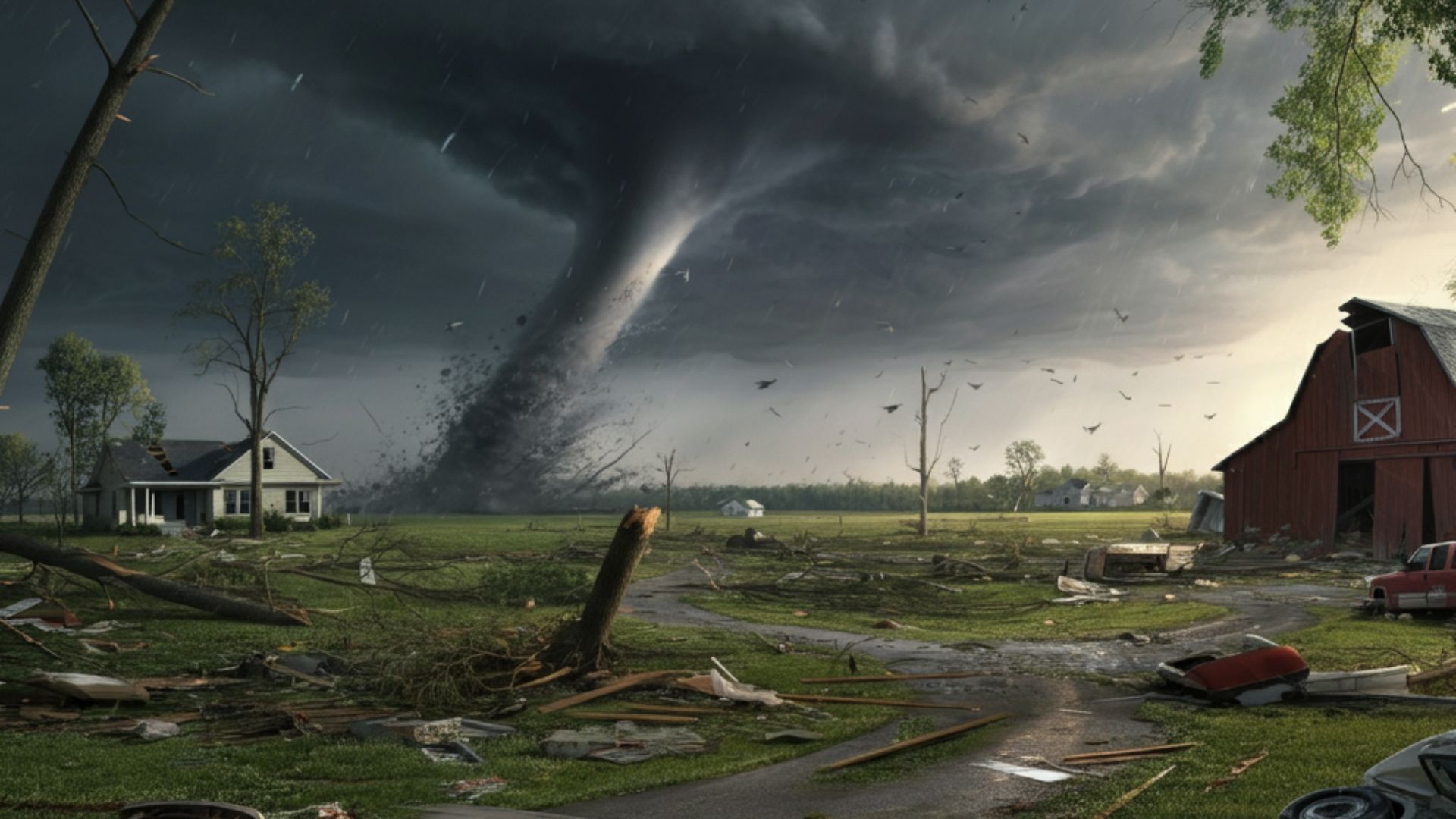The Human Cost of Tornado Devastation
Over the course of three harrowing days, a series of tornadoes tore across nine states in the Midwest and South, leaving heartbreak and destruction in their wake. The storm system, which spawned over 50 tornadoes ranging in strength from EF-2 to EF-4, claimed more than 40 lives. Communities—from small towns in Missouri to remote hamlets in Mississippi—are now grappling with the aftermath of this natural disaster.
Among the hardest-hit areas was Mississippi, where an EF-3 tornado tore through the small community of Plantersville. Winds exceeding 136 miles per hour flattened homes and turned pine trees into lethal projectiles. Tragically, stories like that of 83-year-old Harry Leon Fain, who died in his mobile home, are becoming all too common. Nearby, a high school in Winterboro, Alabama, was so severely damaged that a school bus was hurled into the gym.
For residents like Misty and Bruce Drope of Arkansas, survival came down to seconds. Their home was ravaged by a powerful twister that left only the corner of their house intact. “You’re so thankful you’re alive,” Bruce said, surveying what little remained of their belongings. It was the second time in less than a year that their neighborhood had faced such devastation. These personal stories of survival and loss underscore the emotional toll these storms have on individuals and families.
Compounding the tragedy, states like Kansas saw major highway pileups caused by blinding dust storms, claiming additional lives. And in Oklahoma, heavy winds ignited over 130 wildfires, obliterating nearly 400 homes and contributing to four more deaths. By the end of the weekend, the storms and related wildfires had left more than 320,000 people without power and dozens of communities in need of significant recovery efforts.
Understanding Insurance Coverage for Tornado and Fire Damage
Whether an insurance company pays out under a fire or tornado claim depends on the specific circumstances of the damage and the terms of the homeowner’s insurance policy. Here’s how it typically works:
1. Tornado Damage
- Tornadoes are usually classified as “windstorm damage,” which is covered under most standard homeowners’ insurance policies. This includes damage caused by high winds, flying debris, and structural destruction directly caused by the tornado.
- If the tornado caused secondary damage, like a tree falling on a house or a roof being torn off, that would also fall under the tornado (or windstorm) coverage.
2. Fire Damage
- Fire damage is also a standard coverage in most homeowners’ insurance policies. If a wildfire destroys or damages a home, the claim would typically be filed under the fire coverage portion of the policy.
- If the fire was indirectly caused by the tornado (e.g., high winds downed power lines that sparked a fire), the insurance company would determine the “proximate cause” of the damage. In this case, the fire might still be covered under the fire portion of the policy, but the tornado’s role could influence how the claim is processed.
3. When Both Occur Together
- If both a tornado and a fire damage the same property, the insurance company will assess the primary cause of the damage. For example:
- If the tornado destroyed the roof and the fire burned the interior, the claim might be split between windstorm and fire coverage.
- If the fire was a direct result of the tornado (e.g., a gas line rupture caused by the tornado led to a fire), the insurer might treat it as a single event under the tornado coverage.
4. Deductibles and Limits
- Homeowners typically have a deductible for each type of peril (e.g., windstorm or fire). If both a tornado and fire occur, the homeowner might need to pay separate deductibles unless the insurer treats it as a single event.
- Policy limits also come into play. If the damage exceeds the policy’s coverage limits, the homeowner might not be fully reimbursed.
5. Special Considerations
- Wildfire-Prone Areas: In regions prone to wildfires, some insurers may exclude wildfire coverage or require separate policies.
- Tornado-Prone Areas: Similarly, in tornado-prone areas, insurers might impose higher premiums or deductibles for windstorm coverage.
In summary, the payout depends on the cause of the damage, the policy’s terms, and how the insurer classifies the event. If both a tornado and fire occur, insurers will carefully investigate to determine the primary cause and allocate coverage accordingly.
Tornado Damage and the Strain on Local Economies
When twisters carve through towns, they leave financial ruin in their wake. The damage inflicted over these three days is staggering. Homes, schools, and businesses have been reduced to rubble, and early estimates put the cost of destruction at more than half a billion dollars. Missouri alone reported 12 fatalities and hundreds of damaged buildings, a grim illustration of the cascading challenges faced by affected communities. Unlike larger urban centers with robust recovery mechanisms, many small towns now face the reality that restoring normalcy could take years.
For many people, the numbers behind tornado damage are sobering. A single inch of rainfall flooding a property can result in $25,000 worth of damage; imagine the bill after an EF-4 tornado with 190 mph winds rips through an entire neighborhood. These economic hits do more than empty wallets; they erode the very foundation that keeps small economies alive.
States affected by the string of storms, including Arkansas and Alabama, have already sounded the alarm about the long-term repercussions. Federal and state-level aid will help prop up these communities in the short term, but rebuilding vital infrastructure and housing will require sustained investment and labor. Add in pervasive supply chain issues, and the road ahead looks steep.
Insurance Industry Under Pressure
Severe weather events like this Midwest storm are forcing the insurance industry to adjust, and fast. Over half a billion dollars in claims are expected from this series of events alone, with significant losses anticipated for both the primary insurance and reinsurance markets. For homeowners in tornado-prone areas, policy premiums were already trending upwards due to the frequency and severity of recent natural disasters. This storm system is likely to push those rates even higher.
Insurance-linked securities (ILS) such as catastrophe bonds, which help transfer the risk of unpredictable disasters from insurers to investors, are now under strain. Many cat bond arrangements had already seen their buffers thinned by earlier events, like the California wildfires in January. This latest tornado outbreak may push some of those contracts into their loss attachment thresholds, further stretching insurers’ resources.
But it’s not just the rising costs of claims. Insurers face operational challenges, too. Adjusters have to work overtime to assess widespread damages, while some policies wrestle with nuanced claims involving both direct storm damage and cascading factors like wildfires or flooding. Insurance companies are being forced to innovate under pressure, leveraging technology to improve risk modeling, streamline claims processing, and handle surging demand.
The Role of Technology in Disaster Response and Prevention
It may not yet be possible to “tame” nature, but technology is making strides in preparing for its fury. Tools like predictive analytics and artificial intelligence are transforming how we anticipate and respond to natural disasters like tornadoes. Enhanced radar systems now offer more precise, real-time tracking of storm behavior, giving communities critical time to take shelter.
For the insurance industry, AI-driven predictive models can identify high-risk areas more effectively, allowing insurers to offer customized policies and better-diversified portfolios. This ensures not only equitable coverage for customers but also financial resilience for insurers. Meanwhile, automated claims tools—powered by machine learning—are helping reduce the administrative burden during recovery periods.
It doesn’t stop at forecasting and claims management. Drone technology has become a game-changer in disaster assessments, especially in hard-to-reach or dangerous areas. With a few aerial passes, drones can inspect rooftops, homes, and damaged infrastructure to expedite claims decisions. For those displaced by events such as the tornado outbreak, this means faster repairs and a shorter wait to rebuild their lives.
A Call for Resilience
The tornado outbreak of March 2025 has left a deep scar on the Midwest and South. It’s a reminder of both nature’s wrath and our collective responsibility to adapt to its challenges. While no amount of preparation can eliminate the risk of natural disasters, innovative tools and timely policy adjustments can make a difference. From communities picking up the pieces to industries bearing financial blows, resilience will be the defining factor in moving forward. The storms came, and they shattered lives, but they also underscored the importance of preparedness and adaptability in a world that, for better or worse, feels increasingly unpredictable.


